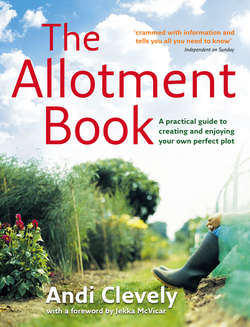Читать книгу The Allotment Book - Andi Clevely - Страница 53
HELPING YOU CHOOSE
Оглавление▸ Compile a list of essential crops: include your favourites and any that might be expensive or elusive in shops. Add flowers for cutting and extras such as green manure or companion plants.
▸ Make a reserve list of plants you would grow if there is room. This could include vegetables like swedes, cabbages and maincrop potatoes that might be readily available locally; those difficult to grow well – cauliflowers or celery, for example; or crops to try for the first time.
▸ Match the essential list to your resources, to check that you have the space to accommodate them all, as well as enough time and energy to see to their needs. Check how long they take to mature, in case you can double-crop the space or fit in a catch- or intercrop.
▸ Decide if you want a long, steady harvest of a wide variety of produce, or perhaps several main flushes for freezing and storing: this will often determine which variety you choose and how much to grow. Make sure not everything matures at once.
▸ Go through catalogues to choose varieties. Note their qualities, especially commendations such as the RHS Award of Garden Merit. Compare with other plot-holders, who might already have discovered the ideal variety for the local soil and climate.
The easiest vegetables to grow
Beetroot, broad beans, carrots, dwarf French beans, courgettes, kale, loose leaf lettuce (left), marrows, New Zealand spinach, perpetual spinach, ridge cucumbers, Swiss chard
Crops with the greatest yield for the least effort
Beetroot, carrots, courgettes (above), dwarf French beans, gooseberries, lettuce, parsley, tomatoes
PLANNING YOUR PLOT You will find it useful to draw up a rough plan of the plot, together with any intended rotation scheme (see pages 32–5) and the positions of permanent plants such as fruit and perennial herbs or vegetables. Break down your list of crops into rotation groups (brassicas, root crops and so on), so you can allocate these to particular beds, and annotate each crop with the length of time it is in the ground – remember to deduct any time that the crop spends growing under glass or in a nursery bed before being planted out.
Now use this raw information to work out the growing sequences in each bed. For example, if you have chosen a fast-growing variety of a particular crop, you might be able to fit two or more successional sowings in the same place before the end of the season. Overwintered crops like Brussels sprouts and autumn-planted onions overlap from one year to the next, but there is usually time before and after they occupy the ground to grow a crop of something else. Identify gaps and see if you can fit in a quick catch crop, or use the space to grow a green manure.
CHIEF CROPS The variety of vegetables, fruit and herbs you could grow is enormous, but practical considerations such as time, climate and limited space inevitably mean that you have to be very selective, concentrating first on staples and favourites, and adding a few minor or speculative crops if you have the room or inclination.
This section of the book includes the most commonly grown allotment crops in their traditional garden groups: roots (potatoes, carrots, for example), legumes (peas, beans), brassicas (cabbages, calabrese), onion family, pumpkin family (squashes, courgettes), leaves and salads (lettuce, spinach), stem and perennial vegetables (celery, asparagus) and fruiting vegetables (sweetcorn, tomatoes), together with a selection of herbs and fruit. For rotation purposes, however, the botanical grouping for certain crops may need to override popular perception – for example, most gardeners regard turnips as a root crop, whereas botanically they are brassicas.
SEE ALSO ▸ Crop rotation pages 32–5 Green manures page 119 Combining crops page 142 Growing under glass pages 170–5 Sowing for succession page 185
